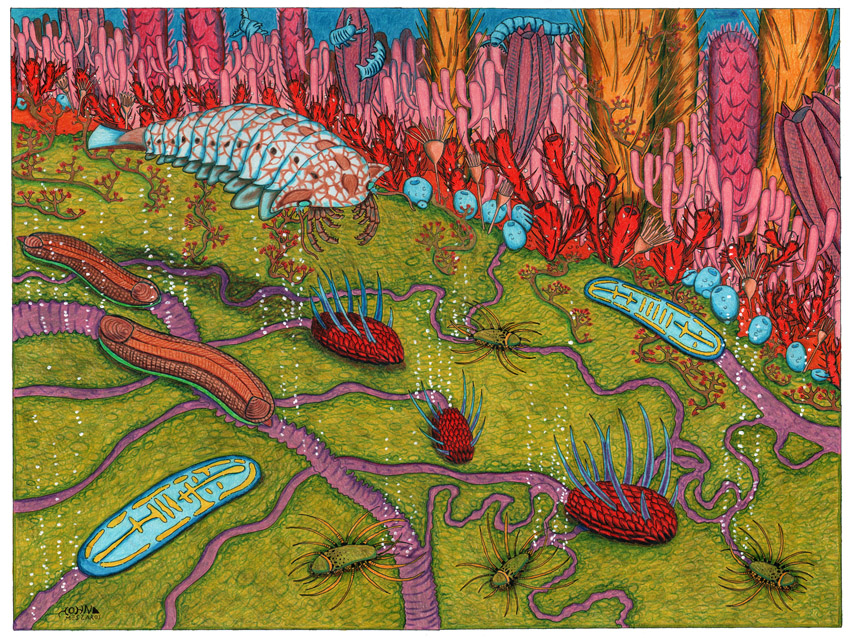ShopDreamUp AI ArtDreamUp
Deviation Actions
Suggested Deviants
Suggested Collections
You Might Like…
Featured in Groups
Description
For the vast majority of Earth’s history, most of the ocean floor was covered by tough microbial mats. It was only in the Cambrian period that these mats were finally broken up by burrowing animals, creating the relatively soft, sediment-based ocean bottoms we know today. During the Cambrian many animals evolved to feed upon these microbial mats using rasping, radula-like organs. Here I’ve illustrated a small assortment of them:
The red, scaled creatures with the blue dorsal spines are Wiwaxia.
The green, yellow-spined critters are Orthrozanclus.
The brown, sausage-shaped things with the shell at either end are Halkieria.
The blue and yellow flatworm-like creatures are Odontogriphus.
Note that most of these creatures have armored scales and/or sharp spines as defenses against the many large Cambrian predators such as Sanctacaris in the upper left. While Odontogriphus was unarmored, I’ve imagined it here as a toxic animal like a seaslug. Its bright coloring advertises its unappetizing nature.
Well-developed microbial mats are stratified into several layers of microorganisms, usually with photosynthesizing cyanobacteria at the top. Here the mat-grazers have chewed away parts of this green cyanobacterial layer, revealing the purple-pink sulfur-utilizing bacterial layer below. The strings of white dots are bubbles of oxygen escaping from the edges of the cyanobacteria.
On the edge of this microbial mat is a forest of sponges, specifically: Crumillospongia, Halichondrites, Takakkawia, Pirania (with tiny Nisusia brachiopods attached to its spines) and Vauxia. Also growing among the sponges are the odd Chancelloria (the spiked, pink-purple sponge-like organisms). While they superficially resemble sponges, several anatomical features of the chancellorids indicate that they are unrelated to Porifera. They may, in fact, be highly modified relatives of Wiwaxia, Halkerieria and Orthrozanclus (although that view is still fairly controversial). Like the mat-grazers, many of these sponges have large spines, presumably to dissuade predators such as the blue lobopods feeding among them.
Note the strings of hydroid-like organisms spreading out of the sponge forest. These are actually the red algaeWaputikia.
Note also the tan, hydroid-like critters tucked among the sponges. These are Dinomischus. Like many Cambrian animals, their exact affinity is uncertain, but their closest living relatives are believed to be tiny, bryozoans-like animals called entoprocts.
The red, scaled creatures with the blue dorsal spines are Wiwaxia.
The green, yellow-spined critters are Orthrozanclus.
The brown, sausage-shaped things with the shell at either end are Halkieria.
The blue and yellow flatworm-like creatures are Odontogriphus.
Note that most of these creatures have armored scales and/or sharp spines as defenses against the many large Cambrian predators such as Sanctacaris in the upper left. While Odontogriphus was unarmored, I’ve imagined it here as a toxic animal like a seaslug. Its bright coloring advertises its unappetizing nature.
Well-developed microbial mats are stratified into several layers of microorganisms, usually with photosynthesizing cyanobacteria at the top. Here the mat-grazers have chewed away parts of this green cyanobacterial layer, revealing the purple-pink sulfur-utilizing bacterial layer below. The strings of white dots are bubbles of oxygen escaping from the edges of the cyanobacteria.
On the edge of this microbial mat is a forest of sponges, specifically: Crumillospongia, Halichondrites, Takakkawia, Pirania (with tiny Nisusia brachiopods attached to its spines) and Vauxia. Also growing among the sponges are the odd Chancelloria (the spiked, pink-purple sponge-like organisms). While they superficially resemble sponges, several anatomical features of the chancellorids indicate that they are unrelated to Porifera. They may, in fact, be highly modified relatives of Wiwaxia, Halkerieria and Orthrozanclus (although that view is still fairly controversial). Like the mat-grazers, many of these sponges have large spines, presumably to dissuade predators such as the blue lobopods feeding among them.
Note the strings of hydroid-like organisms spreading out of the sponge forest. These are actually the red algaeWaputikia.
Note also the tan, hydroid-like critters tucked among the sponges. These are Dinomischus. Like many Cambrian animals, their exact affinity is uncertain, but their closest living relatives are believed to be tiny, bryozoans-like animals called entoprocts.
Image size
859x638px 425.95 KB
© 2011 - 2024 NocturnalSea
Comments17
Join the community to add your comment. Already a deviant? Log In
Oh . . . I don't have words.




































